Physical Address
304 North Cardinal St.
Dorchester Center, MA 02124
Physical Address
304 North Cardinal St.
Dorchester Center, MA 02124
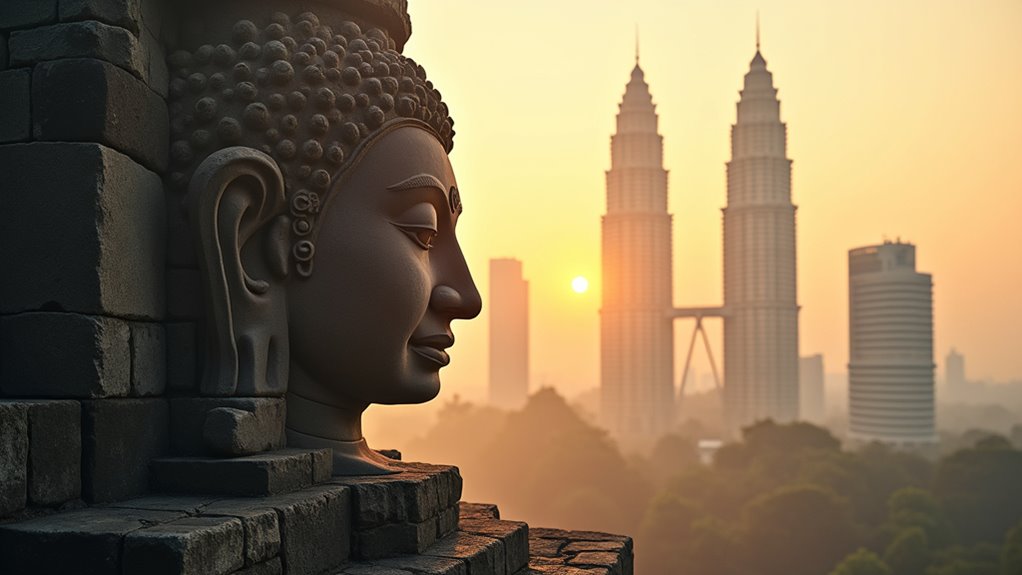
Undecided between Cambodia's ancient temples or Malaysia's modern allure? This guide reveals which Southeast Asian gem fits your travel style.
Choose Cambodia for ancient wonders like Angkor Wat, authentic cultural experiences, and budget-friendly travel (from $20/day). Opt for Malaysia if you prefer modern attractions like the Petronas Towers, better infrastructure, and diverse cuisine influenced by Malay, Chinese, and Indian cultures. Cambodia offers rustic, untouched beaches while Malaysia provides more developed coastal experiences. Your decision hinges on whether you’re drawn to historical immersion or contemporary Southeast Asian flair.
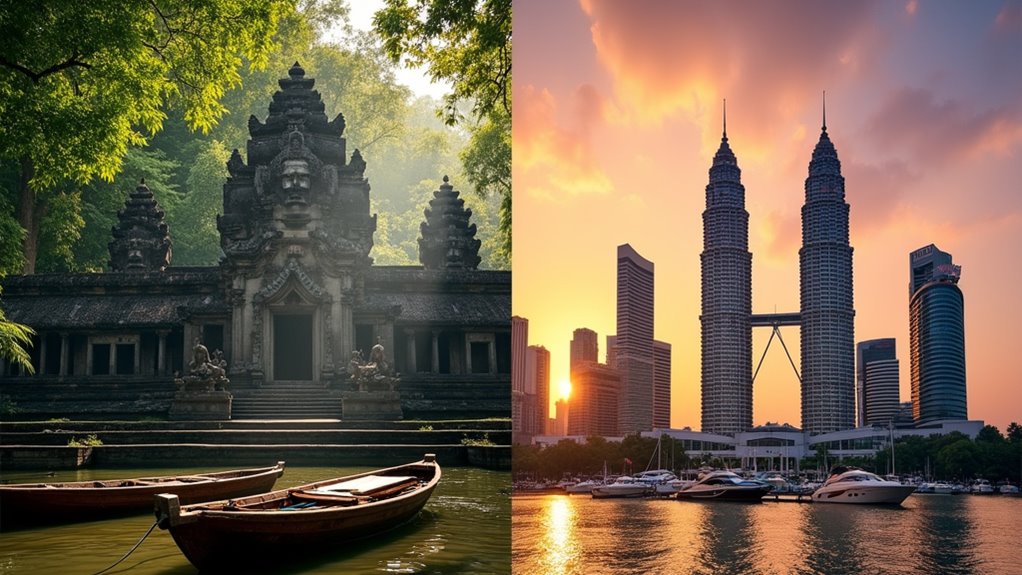
While both countries show impressive post-pandemic recovery, Malaysia clearly dominates the tourism landscape with numbers that dwarf Cambodia’s achievements. Malaysia’s targeting 23.5M visitors for 2025, compared to Cambodia’s more modest 7.5M goal.
Malaysia’s tourist targets triple Cambodia’s, showcasing the vast scale difference between these recovering Southeast Asian destinations.
You’ll find Cambodia growing faster percentage-wise (+23% YoY), but Malaysia offers markedly greater scale. Tourism arrivals in Cambodia reached 101.6% recovery rates compared to 2019 baseline figures. If you’re following visitor patterns, Cambodia draws heavily from neighbors (Thailand, Vietnam, China), while Malaysia cultivates a more global visitor mix.
For your planning, note Cambodia’s strength in temple tourism (Angkor Park drew 146K+ visitors in January 2025 alone), while Malaysia leverages medical tourism and diverse cultural attractions. Malaysia also offers exceptional outdoor adventures across its diverse landscapes that attract nature enthusiasts year-round.
Cambodia’s digitalization efforts (like Angkor’s self-service kiosks) are improving the visitor experience, but Malaysia’s established infrastructure gives it the edge.
Tourism statistics tell one story, but the heart of any travel decision lies in what you’ll actually experience when boots hit the ground.
Cambodia offers ancient wonders that transport you through time – Angkor Wat’s sprawling 162-hectare complex with its 12th-century architecture stands as the world’s largest religious monument. You’ll explore jungle-shrouded Beng Mealea or climb Koh Ker’s seven-tiered pyramid among face-adorned temples. Visitors consistently award Angkor Archaeological Park a remarkable 4.8 rating, recognizing it as one of the modern wonders of the world.
Malaysia counters with jaw-dropping modern marvels. The iconic 452m Petronas Towers dominate Kuala Lumpur’s skyline, while the newly completed 678.9m Merdeka 118 stands as the world’s second-tallest building. Here, engineering feats showcase human innovation rather than ancient ingenuity. Malaysia also offers incredible culinary experiences with Japanese food culture influencing local cuisine across vibrant night markets and upscale restaurants.
Your choice? Weathered stone carvings telling millennium-old stories or gleaming skyscrapers demonstrating contemporary architectural prowess.
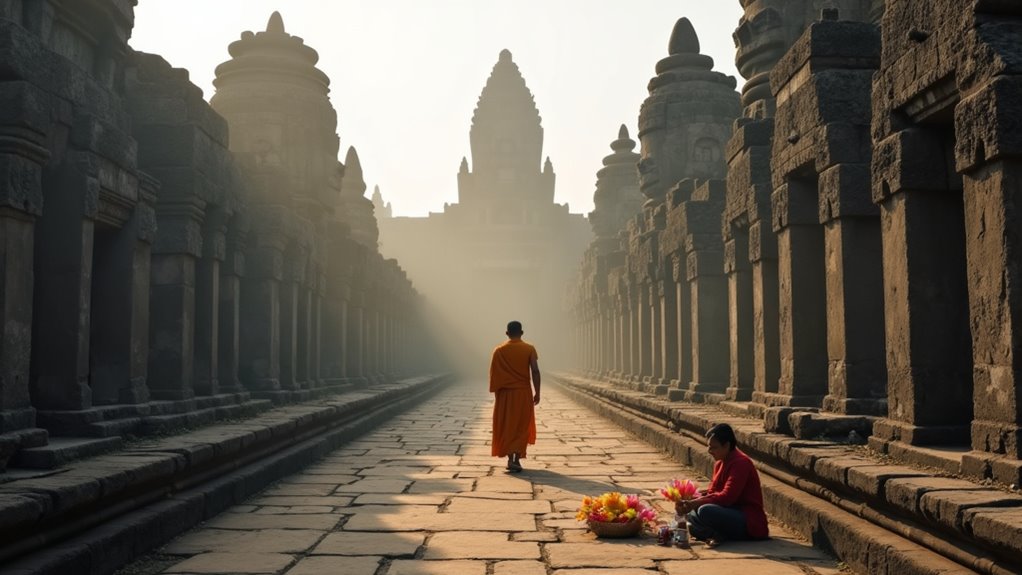
Beneath the surface attractions of both destinations lies the true heart of travel—authentic cultural experiences that create lasting memories.
Malaysia offers a vibrant multicultural tapestry where you’ll encounter Malay, Chinese, and Indian influences daily—from prayer calls to temple incense. You’ll feast on diverse street food like nasi lemak while celebrating festivals from Hari Raya to Chinese New Year. While exploring, you can visit the magnificent Petronas Twin Towers to witness Malaysia’s architectural prowess and cultural pride.
Experience Malaysia’s kaleidoscope of cultures—where prayer calls mix with temple incense and nasi lemak fuels festival celebrations.
Cambodia delivers a predominantly Khmer experience anchored by Buddhist traditions. Watch monks collecting morning alms or catch the mesmerizing Apsara dance performances. The Water Festival and Khmer New Year provide windows into local life. If seeking further authentic experiences in Southeast Asia, neighboring Laos captivates visitors with its laid-back atmosphere and well-preserved heritage sites.
Both countries demand respectful behavior—remove shoes when entering homes, dress modestly at cultural sites, and show deference to elders. These simple courtesies will open the door to meaningful connections with locals and their centuries-old traditions.
Beyond culture, both Malaysia and Cambodia boast spectacular coastal treasures for travelers seeking sun-soaked relaxation.
Malaysia’s beach game is stronger, with Langkawi leading the charge. You’ll find well-developed spots like Pantai Cenang (which gets crowded in peak season) and quieter havens like Pantai Kok. Expect convenient airport access, abundant tourist facilities, and excellent infrastructure to support water activities including guided scuba tours. Malaysia offers visitors a tropical paradise experience with its scenic islands and diverse landscapes.
Cambodia offers a more rustic coastal experience centered around Sihanoukville Beach. While less developed than Malaysia’s shores, you’ll discover untouched islands and less crowded beaches perfect for budget travelers seeking authenticity over luxury.
Island hopping opportunities exist in both destinations, though Malaysia’s islands typically provide more amenities and organized tours.
Your choice comes down to preference: Malaysia’s polished beach experience or Cambodia’s more untamed coastal charm.
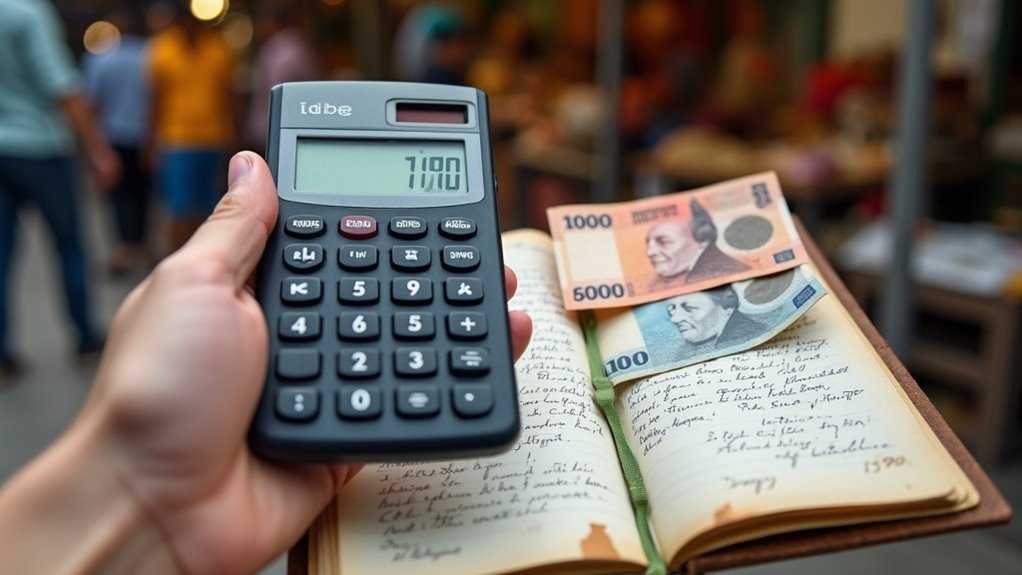
When planning your Southeast Asian adventure, understanding the financial landscape of Cambodia and Malaysia can markedly impact your travel experience. Cambodia offers better value for budget travelers, with daily expenses ranging from $20-$90 compared to Malaysia’s $25-$45 range.
Savvy travelers heading to Southeast Asia should note Cambodia’s wallet-friendly appeal over Malaysia’s costlier options.
You’ll find Cambodia’s accommodations notably cheaper—hostels average $23 per night versus Malaysia’s $47. Food costs slightly favor Cambodia at $27 per day compared to Malaysia’s $33. Both countries fall well within the average daily expenditure of $35 per person typical for Southeast Asia. While both countries offer affordable street food options, Malaysia’s dining scene tends to be more diverse but pricier.
Cambodia allows travelers to live comfortably on a modest budget without sacrificing quality experiences.
Activity costs vary dramatically between destinations. Cambodia’s Angkor Wat tours are reasonably priced, while Malaysia’s adventures like Mount Kinabalu treks command premium rates.
For a week-long trip, expect to budget around $516 in Cambodia versus $709 in Malaysia.
Getting around your Southeast Asian destination can make or break your travel experience, with Cambodia and Malaysia offering dramatically different transportation infrastructures.
Malaysia boasts a sophisticated transport system with extensive urban rail networks, modern highways, and RFID toll systems. You’ll navigate easily between cities via well-maintained roads or frequent flights from KLIA, one of the region’s busiest airports. Malaysia’s maritime capabilities are impressive with 403 ships over 1,000 GRT including bulk carriers, container ships, and various specialized vessels. When comparing destinations in Southeast Asia, Malaysia often stands out for its tourist-friendly infrastructure similar to what you’d find in Indonesia.
Cambodia presents a more adventurous proposition. While national roads connect major destinations, nearly half of the country’s 47,000km network consists of rural roads that can become challenging during rainy seasons.
Domestic flights between Phnom Penh and Siem Reap are reliable but limited compared to Malaysia’s extensive aviation network.
For cross-border exploration, Malaysia’s connections to Thailand via rail provide seamless regional travel that Cambodia simply can’t match.
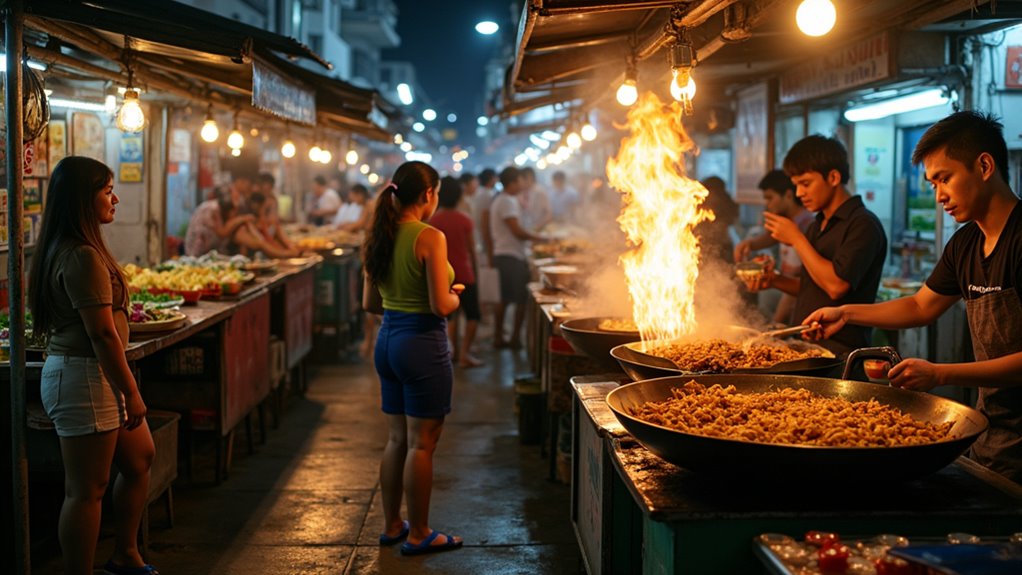
Food lovers traveling through Southeast Asia face a delicious dilemma when choosing between Cambodia and Malaysia, as both countries offer distinctive culinary landscapes worth exploring.
Cambodia delivers sweeter Khmer curries paired with baguettes (French influence), grilled sach ko ang with pickled papaya, and simpler fried noodles with Chinese roots. Traditional Cambodian rice dumplings called Nom Ansom are cylindrical treats wrapped in banana leaves containing pork and mung beans. Don’t miss nom bao steamed buns and chewy banana leaf-wrapped sticky rice desserts.
Cambodian cuisine balances French colonial charm with Chinese-influenced staples, featuring sweet curries, grilled meats, and banana leaf-wrapped treats.
Malaysia counters with spicier laksa featuring coconut milk and seafood, vibrant turmeric-lemongrass satay with peanut sauce, and Mamak-style mee goreng showcasing Indian-Muslim fusion. Malaysia’s flavor combinations reflect its unique blend of Malay, Chinese, and Indian culinary traditions that have evolved over centuries.
The dessert scene dazzles with multicolored kuih and pandan-infused treats.
While both countries share some snack crossovers like fried dough sticks (cha kway/yu cha kway), Malaysia’s food generally offers more complex spice profiles and multicultural influences.
Travelers face three distinct tiers of accommodation options when choosing between Cambodia and Malaysia, with significant price differences impacting your overall budget. Cambodia offers remarkable value with high-rated hostels from $14/night and double-occupancy hotels starting at just $16/night, while Malaysia’s average nightly cost runs about twice as high at $47.
For budget travelers, Cambodia’s beachfront bungalows on Koh Rong under $20 are unbeatable.
Both destinations shine at the luxury level ($200+/night), though with different appeals – Cambodia excels with Khmer-inspired designs and eco-friendly boutiques, while Malaysia boasts urban skyscraper hotels with rooftop infinity pools and rainforest eco-resorts in Borneo.
Weekly projections underscore the difference: expect to spend around $516 in Cambodia versus $709 in Malaysia for comparable stays.
The increasing competition among budget hotels in both countries has created more affordable options for travelers seeking comfortable accommodations without breaking the bank.
Many budget accommodations in Cambodia offer on-site restaurants where guests can sample Cambodian cuisine featuring distinctive dishes that blend Chinese, Indian, and French influences.
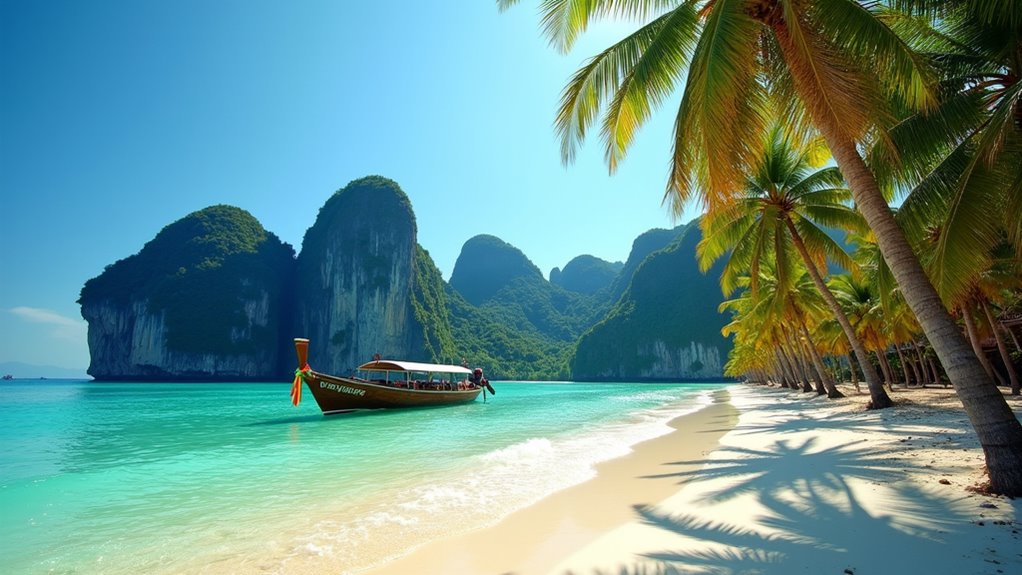
Weather patterns between Cambodia and Malaysia present a fascinating contrast that can make or break your travel experience, with each destination offering distinct seasonal advantages depending on your preferred activities.
Cambodia’s dry season (November-April) delivers reliable sunshine for temple exploration, with comfortable 26-30°C temperatures until March when the heat intensifies above 35°C. Phnom Penh experiences consistently more sunshine hours throughout the year compared to Kuala Lumpur, making it an excellent choice for sun-seekers. The rainy season (May-October) brings lush landscapes but challenging rural travel.
Explore Cambodia’s ancient wonders under cerulean skies, before the punishing heat transforms temple ruins into open-air saunas.
Malaysia’s dual monsoon system requires strategic planning – avoid the east coast during Northeast monsoon (November-March) but embrace its perfect diving conditions during Southwest monsoon (May-September). For travelers on a budget, it’s worth noting that neighboring Laos offers comparable weather patterns to Cambodia but often with more affordable accommodation options. Meanwhile, the west coast offers the opposite pattern.
For maximum flexibility, February-September provides Malaysia’s best overall conditions, while Cambodia shines brightest November-February with minimal rainfall and moderate temperatures.
Whether you’re drawn to Cambodia’s Angkor Wat rising like Ozymandias’s forgotten empire or Malaysia’s Petronas Towers reaching skyward like modern Babel, both destinations offer authentic Southeast Asian experiences on different ends of the spectrum. Your choice boils down to priorities: Cambodia delivers raw culture at lower costs, while Malaysia offers comfort, infrastructure, and diversity. Trust your wallet and wanderlust—there’s no wrong choice when East meets your Western footsteps.